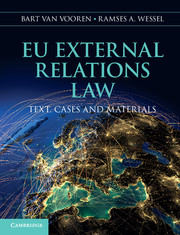Book contents
- Frontmatter
- Contents
- Table of cases
- Table of instruments and legislation
- Preface
- Acknowledgements
- List of abbreviations
- 1 The EU as a global legal actor
- 2 Instruments of EU external action
- 3 Existence of EU external competence
- 4 Nature of EU external competence
- 5 Scope and choice of EU external competence
- 6 The duty of cooperation
- 7 EU law and international law
- 8 The EU and international institutions
- 9 Common Commercial Policy
- 10 EU development policy
- 11 Common Foreign and Security Policy
- 12 Common Security and Defence Policy
- 13 The external dimension of the internal energy market
- 14 The external dimension of freedom, security and justice
- 15 The EU and its neighbours
- Index
- References
9 - Common Commercial Policy
- Frontmatter
- Contents
- Table of cases
- Table of instruments and legislation
- Preface
- Acknowledgements
- List of abbreviations
- 1 The EU as a global legal actor
- 2 Instruments of EU external action
- 3 Existence of EU external competence
- 4 Nature of EU external competence
- 5 Scope and choice of EU external competence
- 6 The duty of cooperation
- 7 EU law and international law
- 8 The EU and international institutions
- 9 Common Commercial Policy
- 10 EU development policy
- 11 Common Foreign and Security Policy
- 12 Common Security and Defence Policy
- 13 The external dimension of the internal energy market
- 14 The external dimension of freedom, security and justice
- 15 The EU and its neighbours
- Index
- References
Summary
Central issues
This chapter deals with a policy area that is traditionally seen as forming the heart of EU external relations law. The CCP not only formed the start of the development of EU external relations, it still forms a key example of a policy area in which internal and external policies are inextricably linked.
In this chapter we will analyse the principles and instruments of the CCP. Irrespective of the scarce references in primary law, the Union has developed several instruments to shape this policy area. We also look at the roles of the Union institutions and the applicable decision-making procedures.
Finally, this chapter will analyse the relation between the internal market and the external trade, and address the question of how this relationship influenced the development of CCP.
Introduction
The CCP is ‘the mother of all EU external relations policies’. In the early days, many authors would even have a tendency to equate EU external relations law to CCP, and still many textbooks would explain basic notions underlying EU external relations law with extensive references to CCP, so as to illustrate the development of the scope of an existing competence. It is true that the existence, nature and scope of external competences (see Chapters 3–5) have largely been defined by reference to early cases in the area of CCP. In this chapter we will occasionally return to these basic notions, but will predominantly look at CCP as an institutional and substantive policy area.
- Type
- Chapter
- Information
- EU External Relations LawText, Cases and Materials, pp. 276 - 310Publisher: Cambridge University PressPrint publication year: 2014



